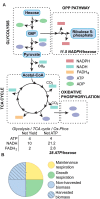Respiratory energy demands and scope for demand expansion and destruction
- PMID: 36271857
- PMCID: PMC10069906
- DOI: 10.1093/plphys/kiac493
Respiratory energy demands and scope for demand expansion and destruction
Abstract
Nonphotosynthetic plant metabolic processes are powered by respiratory energy, a limited resource that metabolic engineers—like plants themselves—must manage prudently.
Conflict of interest statement
Conflict of interest statement. None declared.
Figures





References
-
- Ainsworth EA, Long SP (2005) What have we learned from 15 years of free-air CO2 enrichment (FACE)? A meta-analytic review of the responses of photosynthesis, canopy properties and plant production to rising CO2. New Phytol 165: 351–371 - PubMed
-
- Amthor JS (1989) Respiration and Crop Productivity. Springer-Verlag, New York, NY
-
- Amthor JS (1994) Respiration and carbon assimilate use. InBoote KJ, Bennett JM, Sinclair TR, Paulsen GM, eds, Physiology and Determination of Crop Yield. American Society of Agronomy, Madison, WI, pp 221–250
-
- Amthor JS (2000) The McCree–de Wit–Penning de Vries–Thornley respiration paradigms: 30 years later. Ann Bot 86: 1–20
-
- Amthor JS (2010) From sunlight to phytomass: on the potential efficiency of converting solar radiation to phyto-energy. New Phytol 188: 939–959 - PubMed
Grants and funding
LinkOut - more resources
Full Text Sources

